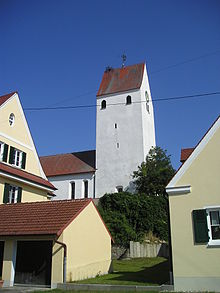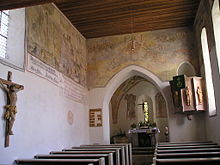St. Mary's Church (Bühl im Ries)
The St. Marien Church in Bühl im Ries , part of the municipality of Alerheim in the Donau-Ries district ( Bavaria ), is an Evangelical Lutheran parish church decorated with historical frescoes .
location
The church, surrounded by a fortified cemetery, is located on a hill in the middle of the village (Am Kirchberg 6).
history
The previous building was built in 1193 as the choir tower church of a fortified church. 1270 the counts handed from Oettingen the patronage of the Cistercian convent being established Kirchheim . In 1307 the patronage right with the church set was transferred to the cathedral chapter in Augsburg . In the 16th century the church became Protestant as a result of the Reformation . Wooden galleries were built into the west and north of the church.
Around 1680, the nave was extended by four meters, with the northern nave wall of the previous church being retained, but being drawn higher. At the same time, the south wall of the nave was narrowed so that it is in alignment with the south side of the tower. The tower, which still has the choir of the previous church in the basement, was also redesigned and raised around 1680. At that time the sacristy was added to the north side of the tower. Major renovations took place in 1895.
Building description
The single-nave building has a flat roof and a wooden ceiling on the inside. The choir in the basement of the undivided tower in the east of the church has a groin vault . The square tower, which is about half a meter wider in the north than the nave, is closed with a gable roof ; On the gable ends there is a clock tower over two round-arched sound openings. The distance between the two sound openings on the other sides of the tower appears unusually large.
To the west of the church, outside the cemetery wall, is a war memorial in the form of three crosses.
Frescoes
The church has extensive paintings on the nave walls and in the choir, which date from the 13th to 17th centuries. They were uncovered from 1946 to 1948 and the church painters Reißner and v. Löhneysen and von Schmitt, Augsburg, partially restored. In this context, the gallery on the north wall was removed in favor of the frescoes. The remaining west gallery partially covers the frescoes.
Choir room
The frescoes in the choir are the oldest in the church and were created in the 13th, 14th and 15th centuries. They show St. Christophorus (around 1300) in courtly garb, St. Peter (after 1300) as well as medallions with the evangelist symbols (man, lion, bull and eagle) and eight angels making music in the vault (around 1450). "Particularly interesting ... are the youthful, almost feminine-looking, soft facial features" of the well-preserved Christophorus; perhaps the representation is influenced by the mystical attitude of the Kirchheim Cistercian women. Bühl is located on the little creek Schwalb , which led to frequent floods - the representation of St. Christophorus can also be seen in this context. Peter, also painted in the spirit of mysticism, is depicted with a book, probably the Bible, and with the key of heaven. The angels in the vault spandrels were painted around 1420. In the apex of the groin vault, the lamb is shown as a symbol of Christ, walking with a waving white flag of victory with a cross on it.
South wall
A seated, pregnant (?) Holy pilgrim is depicted on the southern wall of the nave - perhaps Mary from the biblical scene in which she visits her cousin Elisabeth. The fresco dates from the end of the 14th century to around 1500. Further, unidentifiable traces of paint on the south wall were whitewashed again. The large three-part mural, like the other murals donated by Bühler Bauern in 1681, shows the calling of a prophet ( Ezekiel or Jeremiah ?), The conversion of Saul and - disturbed by a later installation of a window - the Christmas event (Annunciation to the shepherds and adoration of the Kings).
North face
The mural from 1681 shows in two large pictures the baptism of Jesus by John in the Jordan and - after a church window - the paradise with animals and the fall of Adam and Eve, finally in three rows in three small individual scenes the story of the passion and the resurrection of Jesus. Three other small pictures on the north wall show a ripe pomegranate , then, probably of Romanesque origin, an apostle cross with a wheel rim, cross and hand of oath and finally another depiction of Peter under the gallery.
East wall
The east wall shows a large area of the Last Judgment on the choir arch . The fresco was created in the late 17th century.
Further equipment
- A modern wooden pulpit hangs in the southeast corner of the nave (access via a staircase in the tower) and has four wooden figures of "witnesses of faith" (John the Seer, Moses, the disciple John and the Apostle Paul). They were carved by the sculptor Ernst Steinacker .
- Above the altar in the choir room hangs a gilded cross made of six angels playing music, also a work by Steinacker.
- The Romanesque choir window behind the altar is modern with colorful glass and shows the Christmas story with two angels.
- The baptismal font is on the left of the choir arch.
- A large wooden cross with a corpus is attached to the historic north wall; It was donated in 1681.
- The wooden gallery in the west of the church (access in the north from the outside) hides the old fresco painting in places. The organ brochure is in five parts.
- A stone relief of the crucifixion above the church portal and the stone relief "Ladder to Heaven" from the Jacob's Dream on the churchyard wall are other works by Steinacher.
- Four Jurassic limestone tombstones date from the end of the 18th century and 1800.
Appreciation
The nave frescoes are a rare example of such pictorial representations made in Protestant churches in the 17th century. While the paintings in the choir are of high artistic quality, the frescos in the nave are of a rather rustic, naive character. Hans Keitel described the theological program of the frescoes in detail.
literature
- Bruno Bushart and Georg Paula (edit.): Handbook of German Art Monuments by Georg Dehio , Bavaria III Swabia. 2nd, revised edition, Munich / Berlin: Deutscher Kunstverlag 2008, p. 225.
- Hans Keitel: The St. Marien Church in the Protestant parish village of Bühl im Ries and its well-preserved frescoes. Reprint from the magazine “Nordschwaben Der Daniel”, issue 4 (1986), Aalen: Konrad Theiss Verlag.
- Bühl / Rudelstetten . In: Karl Lotter (Ed.): Rieser Kirchenbuch - history of the evangelical parishes of Ries , Nördlingen 1956, pp. 189–195.
- Buhl . In: Ernst Bezzel, Klaus Neureuther and Albert Schlagbauer (eds.): Evangelical parishes in Ries - deanery districts Donauwörth, Nördlingen, Oettingen and the eastern region of the church district Aalen . 1981, pp. 23-27.
- Buhl . In: Karl Gröber and Adam Horn (arrangement): Die Kunstdenkmäler von Bayern, Administrative Region Swabia, I, District Office Nördlingen , Munich: R. Oldenbourg 1938, p. 92f.
Web links
Individual evidence
- ↑ Keitel, p. 1
- ↑ a b Keitel, p. 5
- ↑ a b c d Gröber / Horn, p. 92
- ↑ Bushart / Paula, p. 225
- ↑ Bushart / Paula, p. 225; Keitel, p. 1
- ↑ Keitel, pp. 1ff.
- ↑ Keitel, p. 2
- ↑ Keitel, p. 6
- ↑ Keitel, p. 10
- ↑ Keitel, p. 18
- ↑ a b Keitel, p. 19
- ↑ Keitel, pp. 1, 19
- ↑ Gröber / Horn, p. 93
Coordinates: 48 ° 50 ′ 4.8 ″ N , 10 ° 39 ′ 23.8 ″ E








